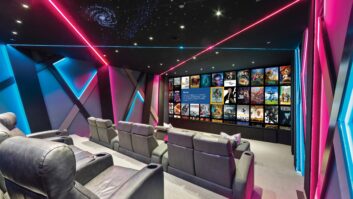TWICE:Let’s talk product. What’s hot and what’s not?
TOM EDWARDS: In television, more than half of the projection sets being sold at retail are high definition, and most are 16 x 9 widescreen. That’s critical for profitability.
The analog sets have done fairly well too, but it’s been price driven. The manufacturers came up with price reductions starting before September in anticipation that digital would come up with it.
What is being hurt are the small screen sizes, the 13-, the 19-inch TVs. These are what most of the specialty stores have basically given up trying to complete against. You have to have it, you have to promote it, but it is not a profit item.
TWICE:How do you explain the popularity of HD when there is still so little programming?
SHELLEY MILLER: It’s still the best way to watch a DVD, and people want to be future-proof. There’s no doubt that anyone who is investing $2,500 to $6,000 on a TV wants to make sure they buy something that they don’t perceive as obsolete, regardless of whether they ever take that next step and add a set-top box or whatever.
RICK SOUDER: I think a lot of us had an awful lot of angst a couple of years ago over the three conflicting standards — what would happen, what wouldn’t happen — and it turned out the customer really didn’t care. I don’t think it’s because they are uneducated or frivolous; I think it is to Shelly’s point they are making a significant investment and they want to invest in something that they are going to have some flexibility with over time.
TWICE:What else is strong?
EDWARDS: Home theater in a box (HTiB) has been phenomenal. Now there’s a category where, while the average price of almost every product has declined, the average price of a home theater in a box is going up because of the DVD being included. About half the dollars of home theater in a box that are being sold come from products with DVD players integrated into it.
But with DVD going to over 14 million units last year, I don’t think there’s going to be enough to even show on the radar this quarter, because, you know, it is going to sell through the walls. It happened in 1999, where the Christmas season was so good there was no inventory for the first part of the year 2000. And I think we are going to go into that same situation.
TWICE:Are we facing pipeline issues this quarter?
GREG DREW: We are concerned about that right now because we’ve got some product transitions coming up, and we know some of our vendors for some of these best-moving products are out and were completely allocated.
Part of it is also the byproduct of some of our own decisions — we pulled back on some of our commitments because we were planning for those bad things that we knew about [Sept. 11] and those things that we didn’t know. It is better to under-perform a little bit and not end up with a lot of goods than have it the other way around. So we’re gonna scramble. But I would rather be chasing product at this time of year than trying to solve the other problem.
DAVE WORKMAN: There really are only two kinds of buys in this business: A bad buy and a worse buy. The bad buy is where you bought too little, and the worse buy is where you bought too much.
We were fortunate. We scrambled, because like everybody else we had to revise our projections with the manufacturers after Sept. 11. But we were careful trying to balance our inventories, and we came out in a very healthy position. And we were able to secure enough of the upside inventories in the specific technologies that are key to our business.
TWICE:Have DVD players been able to pull home audio out of its tailspin?
MILLER: I haven’t seen it take the component business upward in our experience, although it has taken the HTiB business upward dramatically. So there is a definite correlation there. The attachment rate is very high. Not as high as it could be or should be, which we are still working on. But we are also working very hard at our component business because that’s our strength, that’s our heart, and that’s what differentiates us from everybody else. But we are not seeing it yet.
TWICE:Dave, what has Ultimate been doing to goose home audio?
WORKMAN: We have had to sort of reinvent ourselves in audio as it relates to the consumer, rather than trying to be the last guy holding the flag for surround sound receivers and saving the world from bad sound. We would rather look for what the customer is telling us they want to buy, but adapting that pattern over to where our strengths are.
Specifically, we have looked to some of our displays in the audio area, embracing the DVD home theater product, but clearly looking to not have it relegated to $599 and below.
Now that doesn’t mean you abandon your component roots, because there is still obviously a market for the component business. But it is really being able to listen very carefully to the consumer and what they tell you they want to buy, and adapting it to your business, to where your strengths are. And the result of all of that gave us a comparable store sales increase in the audio category for the holiday season.
TWICE:What’s the read on PVRs?
EDWARDS: PVRs haven’t found themselves yet because there hasn’t been a driver like DVD had with DIVX. DIVX did a lot for DVD because the wars between the giants, and the involvement of the studios, increased consumer awareness.
But even without that, PVR was up 52 percent over the holidays because it is a last minute gift item. The average pricing was down a little, but still strong.
TWICE:So between DVD and PVR, would it be premature to announce the death of VHS?
EDWARDS: Yes. I think VHS will be around for a real long time because the American male likes to stack boxes on top of one another. He is going to have his cable box, his PVR box, his DVD box and his audio box, until his wife says no.
There’s also a tremendous library of pre-recorded tapes that people have made for themselves with camcorders. They’re not going to obsolete the VCR for this. There’s no question it will drop off, but the VCR today is like a toaster: If it breaks, you don’t have it fixed, you throw it away and buy another one.
WORKMAN: The only difference is the toaster sells for more money.
TWICE:And what of mobile audio?
EDWARDS: Car audio is phenomenal. Cassette tapes in-dash, that’s dropped off. But the mobile multimedia market has grown tremendously, and that includes the entertainment and the navigation. It’s stronger in the original installation coming out of the factories, but the aftermarket now is starting to grow in big quantities.
MILLER: Our multimedia businesses double and triple and quadruple what it was, and satellite radio and mobile too. Anything that’s got XM built in. Or at least XM-capability.
EDWARDS: The effects of the Internet and the economy on non-digital products are really strange. VCR, like I said, will stay around. Cassette tape is dying off to CD audio, and the home CD decks are dying off to DVD on the low end and the changers on the very high end. Plus the CD recorder is taking that business away. CD recorders are very hot.
People want the step-up product. If they are going to invest the dollars, they are going to go for the top, although the very top end of the line is suffering.
DREW: People who come to our site are still buying the better goods, but they are going for the slightly lower ticket product that is available. For example, $700, $800, $900, $1,000 cameras are selling like crazy, but we are not selling quite as many $4,000 TVs.
So people are still treating themselves, but they are just being a little bit more cautious. They are downshifting into categories where they are buying the better goods, but still spending a little bit less money.













